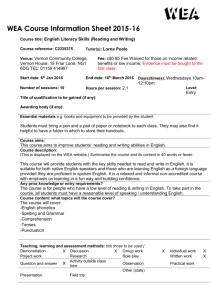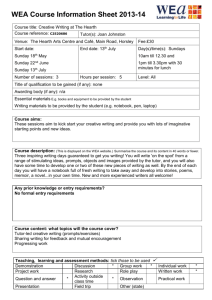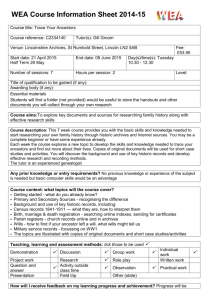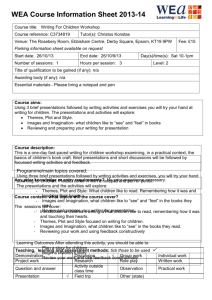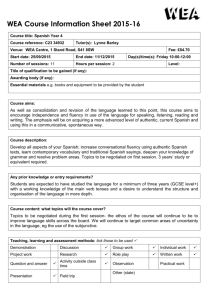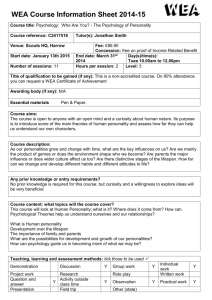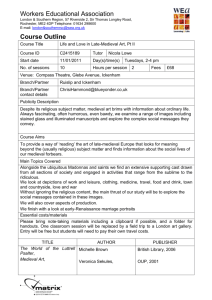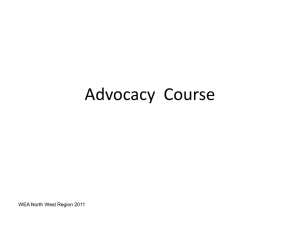course outline - Course Search
advertisement
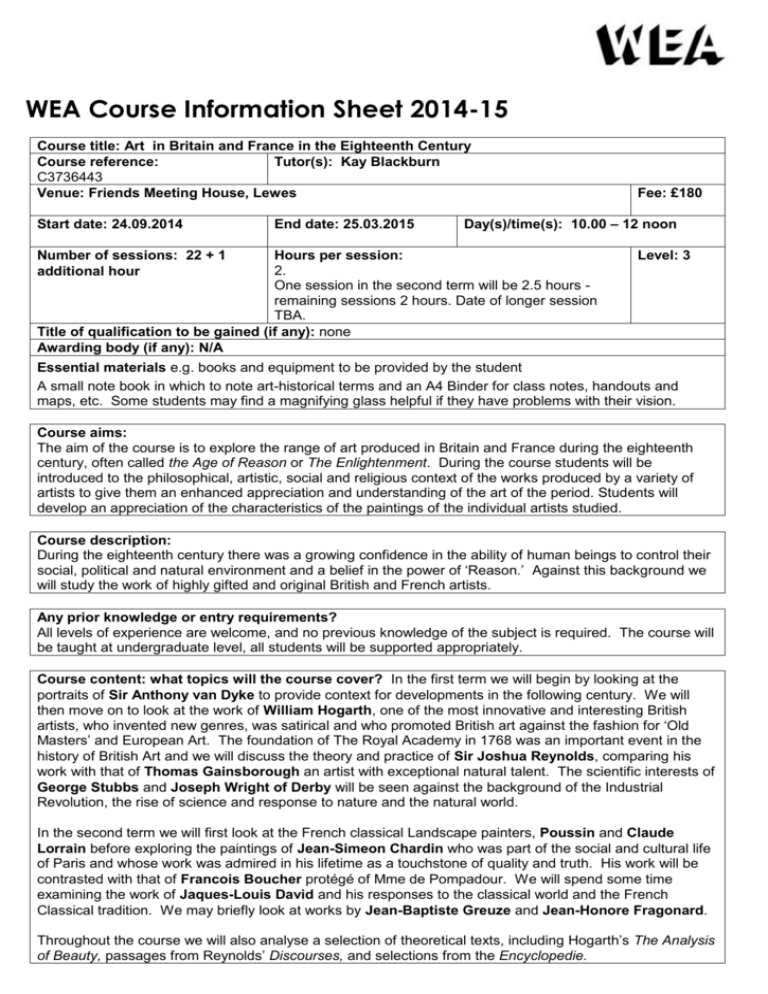
WEA Course Information Sheet 2014-15 Course title: Art in Britain and France in the Eighteenth Century Course reference: Tutor(s): Kay Blackburn C3736443 Venue: Friends Meeting House, Lewes Start date: 24.09.2014 Number of sessions: 22 + 1 additional hour End date: 25.03.2015 Fee: £180 Day(s)/time(s): 10.00 – 12 noon Hours per session: 2. One session in the second term will be 2.5 hours remaining sessions 2 hours. Date of longer session TBA. Title of qualification to be gained (if any): none Awarding body (if any): N/A Level: 3 Essential materials e.g. books and equipment to be provided by the student A small note book in which to note art-historical terms and an A4 Binder for class notes, handouts and maps, etc. Some students may find a magnifying glass helpful if they have problems with their vision. Course aims: The aim of the course is to explore the range of art produced in Britain and France during the eighteenth century, often called the Age of Reason or The Enlightenment. During the course students will be introduced to the philosophical, artistic, social and religious context of the works produced by a variety of artists to give them an enhanced appreciation and understanding of the art of the period. Students will develop an appreciation of the characteristics of the paintings of the individual artists studied. Course description: During the eighteenth century there was a growing confidence in the ability of human beings to control their social, political and natural environment and a belief in the power of ‘Reason.’ Against this background we will study the work of highly gifted and original British and French artists. Any prior knowledge or entry requirements? All levels of experience are welcome, and no previous knowledge of the subject is required. The course will be taught at undergraduate level, all students will be supported appropriately. Course content: what topics will the course cover? In the first term we will begin by looking at the portraits of Sir Anthony van Dyke to provide context for developments in the following century. We will then move on to look at the work of William Hogarth, one of the most innovative and interesting British artists, who invented new genres, was satirical and who promoted British art against the fashion for ‘Old Masters’ and European Art. The foundation of The Royal Academy in 1768 was an important event in the history of British Art and we will discuss the theory and practice of Sir Joshua Reynolds, comparing his work with that of Thomas Gainsborough an artist with exceptional natural talent. The scientific interests of George Stubbs and Joseph Wright of Derby will be seen against the background of the Industrial Revolution, the rise of science and response to nature and the natural world. In the second term we will first look at the French classical Landscape painters, Poussin and Claude Lorrain before exploring the paintings of Jean-Simeon Chardin who was part of the social and cultural life of Paris and whose work was admired in his lifetime as a touchstone of quality and truth. His work will be contrasted with that of Francois Boucher protégé of Mme de Pompadour. We will spend some time examining the work of Jaques-Louis David and his responses to the classical world and the French Classical tradition. We may briefly look at works by Jean-Baptiste Greuze and Jean-Honore Fragonard. Throughout the course we will also analyse a selection of theoretical texts, including Hogarth’s The Analysis of Beauty, passages from Reynolds’ Discourses, and selections from the Encyclopedie. Teaching, learning and assessment methods: tick those to be used Demonstration * Discussion * Group work * Project work Research * Role play Activity outside class Question and answer * Observation * time Other (state) gallery visit Presentation * Field trip Individual work Written work Practical work How will I receive feedback on my learning progress and achievement? Work in the whole group and in smaller groups will be used, together with question and answer sessions to help you chart your progress. You will keep an individual learning record and the tutor will discuss your progress with you and will be available if you have any personal queries or want advice. Learning outcomes: these are the intended outcomes and may be revised in discussion with the class. Students are encouraged to think about and identify their own individual outcomes. By the end of the course, students should be able to: 1. Recognise the characteristics of the individual artists studied 2. Explain the cultural, theosophical and political context of the period 3. Compare and contrast the art of Britain and France in the eighteenth century 4. Describe the impact of the Academies of Britain and France on the art of the period 5. Analyse individual works of art to explore their meaning using appropriate art historical terminology Reading and information sources: Is any reading/preparation essential or desirable? No prior reading is required. For internet search on individual artists, www.artcyclopedia.com is a good website which also gives access to museum and art gallery websites For an overview of the history of the period, Norman Hampson’s The Enlightenment published by Penguin 1968, or Anthony Pangden’s The Enlightenment: And why it Still Matters Today might be of interest. Roy Porter’s English Society in the Eighteenth Century gives an excellent historical background to England in the period Suggestions for progression to further study or for using the skills and knowledge gained: You might like to enrol on other WEA Art History Course or Day Schools or consider Open University Courses. Visits to galleries and exhibitions will help you further expand your knowledge. You can read about your entitlements and responsibilities as a WEA student in our leaflet, Services for Students here http://www.wea.org.uk/courses/information This includes information on fees, learning support and financial support. As part of your first course you accept a learning agreement. This applies to all courses you take in this academic year. You should have a copy of the learning agreement (the tear-off portion of your enrolment form), but if not please ask for a copy from your tutor. You can enrol online for some courses http://www.wea.org.uk/courses or contact London & Southern Regions Support Centre: Email: london&southernrsc@wea.org.uk Tel: Freephone 0800 328 1060 The Workers’ Educational Association (WEA) is a charity registered in England and Wales (number 1112775) and in Scotland (number SC039239) and a company limited by guarantee registered in England and Wales (number 2806910). Registered Office: Workers’ Educational Association, 4 Luke Street, London, EC2A 4XW
